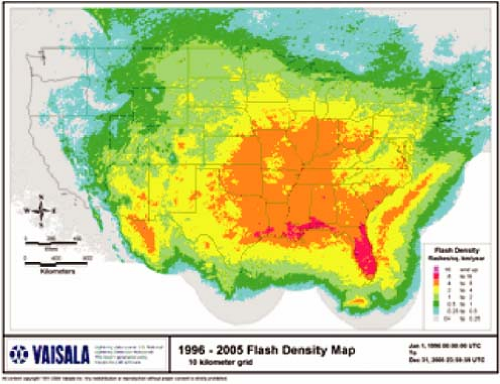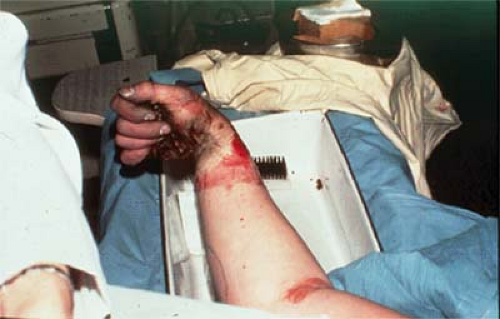Electrical Current and Lightning Injury
Mary Ann Cooper
Christopher J. Andrews
Ronald L. Holle
Electrical current can be a great force for good in the community. Our society has become dependent on electric power for heating and cooling, cooking and food preservation, motive force, and the multitude of electronic gadgets that make our lives easier, more enjoyable, and more productive. Nonetheless, uncontrolled electrical current causes severe injuries when it enters the body accidentally. There are two major ways by which this occurs: technical electrical current and lightning current.
Prevention of electrical and lightning injuries, like that of drowning, is the most cost-effective approach to these devastating injuries.
Aggressive resuscitation is indicated after first attention to rescuer safety.
Injuries can be profound, but some cardiac functional recovery may occur. With rare exceptions, hypoxic brain injury seldom recovers to any great extent.
Emergency department (ED) assessment and attention to noncardiac electrical trauma is important for patient survival and long-term functional recovery.
Introduction
Electrical current can be a great force for good in the community. Our society has become dependent on electric power for heating and cooling, cooking and food preservation, motive force, and the multitude of electronic gadgets that make our lives easier, more enjoyable, and more productive.
Electrical current offers many therapeutic opportunities in modern medicine. With defibrillation, cardiac arrhythmias can be treated and life-threatening rhythms terminated. With stimulation, bone growth can be facilitated. Physical therapies rely on many means of electrical stimulation. Even in psychiatry, electroconvulsive therapy has a body of support.
Nonetheless, uncontrolled electrical current causes severe injuries when it enters the body accidentally. There are two major types of electricity that may do this: technical electrical current and lightning current.
Technical Electrical Current
Technical electrical current can cause massive, deep injury and not infrequently death. Devastating internal burning may be seen, and some victims experience tetanic skeletal muscle contractions and “lock” to the source of current, prolonging exposure and multiplying the injury (Fig. 32-1). This “no let go” phenomenon has also been linked to symptoms of posttraumatic stress disorder.1 Current passing through on the heart can induce physical injury (burning, bruising, and physical disruption, for example) and arrhythmias, of which asystole and ventricular fibrillation (VF) cause cardiac arrest and death unless immediate resuscitation is initiated. A period of pulseless electrical activity can lead to hemodynamic impairment and cardiopulmonary arrest. Even low-voltage sources can cause cardiac arrest, often with little external evidence, as in a bathtub incident. In these cases skin resistance is lowered to such an extent that no skin burns occur but the current affects the heart maximally.
Lightning Current
Lightning current presents a unique injury constellation of its own quite different from that seen in technical electrical injury. Burns are of minimal concern; and although cardiac injury is significant, central; nervous system and autonomic nervous system injury can be marked. Both types of injury carry a similar, severe long-term psychiatric legacy.2
Blunt trauma and blunt head injury may be caused by both types of current because of muscle contraction or falls, a blast effect from arcing and explosions, or the concussive effects of being close to the point of a lightning strike. Long-term neurocognitive damage with chronic pain, sometimes termed
“post–electric shock syndrome,” has been consistently identified. This syndrome contributes to marked long-term disability and dysfunction.
“post–electric shock syndrome,” has been consistently identified. This syndrome contributes to marked long-term disability and dysfunction.
Injuries From Technical Electrical Current and Lightning Current
Technical electrical current:
Physical injuries such as burns, fractures, and contusions
Arrhythmias, including VF and asystole
Fatal cardiac contractile impairment
Pulseless electrical activity
Lightning current:
Most lightning-strike patients have minimal cardiac injury; but when more injury is present, it may involve significant sequelae.
Marked central nervous system and autonomic nervous system injury.
Burns are of minimal concern.
Both types of current:
Blunt trauma
Blunt head injury
Long-term neurocognitive damage with chronic pain (post–electric shock syndrome)
Epidemiology
Electrical Injury
Various groups are at particular risk for electrical injury. The purpose of identifying them is to identify circumstances where protective strategies and procedures may be concentrated.
A recent study from Sweden identified patterns of injury in a wide population of 285 cases.3 Results are presented in Table 32-1, along with the results of two U.S. studies.4,5 It is surprisingly difficult to obtain comprehensive epidemiologic analyses of electric shocks for a particular country. Furthermore, it is difficult to obtain exactly corresponding data from different reports to compare studies.
The Swedish study3 is perhaps the most comprehensive to date and is, therefore, important. In this study the investigators defined electrocution as a cause of death*1 that included death from electric shock, from burns caused by arcs, and from falls from a height due to electric shock. It must be remembered that falls should prompt a search for injury beyond those due to electrical current.
The vast majority of the injured were male (94%); 132 incidents (46%) occurred in an industrial situation and 151 (53%) during recreation (two cases unknown). Over the total period, industrial and recreational deaths tended to parallel each other in a decreasing trend. Similarly, deaths due to high-voltage current (>1,000 V), as compared with deaths due to low-voltage current (≥1,000 V) decreased, the former by a larger percentage. There were 36 adolescent deaths (13%). Approximately 20% of cases involved alcohol.
Risk Groups for Electrocution
Various groups are at particular risk for electrocution:3
Males
Adolescents
Utility, agricultural, and construction workers
The following activities are significantly dangerous:
Performing unauthorized repairs
Using alcohol while working with electricity
Overlooking overhead power lines
Employing poor judgment
Neglect of proper use of protective devices and procedures is a significant contributor to electrocution in work-related cases.
The most dangerous situation remains accidental contact with aerial power lines, and these deaths were roughly equally distributed between recreational and industrial deaths. Such incidents accounted for 40% of the total. Of these, the most dangerous location was railway lines (61 of 113, or 54%), followed by forest and field lines (23 of 113, or 20%) and public roads (7 of 113, or 6%). The remaining 22 deaths due to contact with a power line occurred in substations, farms, over watercourses, and in other minor locations.3
Carelessness, including the lifting of ladders, media truck satellite probes, metal poles, and other long metal apparatus into overhead lines, is commonly involved in such
injuries. Nor can one ignore the role of illegal activities in these incidents, such as unauthorized entry into railway property. The findings of the Swedish study emphasize the importance of staying clear of fallen lines as well as the necessity of keeping domestic electrical apparatus in good repair.
injuries. Nor can one ignore the role of illegal activities in these incidents, such as unauthorized entry into railway property. The findings of the Swedish study emphasize the importance of staying clear of fallen lines as well as the necessity of keeping domestic electrical apparatus in good repair.
Table 32-1 • Epidemiology of Electrical Injury | |||||||||||||||||||||||||||||||||||||||||||||||||||||||||||||||||||||||||||||||||||||||||||||||||||||||||||||||||||||||||||||||||||||||||||||||||||||||||||||||||||||||||||||||||||||||||||||||||||||||||||||||||||||||||||||||||||||||||||||||||||||||||||||||||||||||||||||||||||||||||||||||||||||||||||||||||
|---|---|---|---|---|---|---|---|---|---|---|---|---|---|---|---|---|---|---|---|---|---|---|---|---|---|---|---|---|---|---|---|---|---|---|---|---|---|---|---|---|---|---|---|---|---|---|---|---|---|---|---|---|---|---|---|---|---|---|---|---|---|---|---|---|---|---|---|---|---|---|---|---|---|---|---|---|---|---|---|---|---|---|---|---|---|---|---|---|---|---|---|---|---|---|---|---|---|---|---|---|---|---|---|---|---|---|---|---|---|---|---|---|---|---|---|---|---|---|---|---|---|---|---|---|---|---|---|---|---|---|---|---|---|---|---|---|---|---|---|---|---|---|---|---|---|---|---|---|---|---|---|---|---|---|---|---|---|---|---|---|---|---|---|---|---|---|---|---|---|---|---|---|---|---|---|---|---|---|---|---|---|---|---|---|---|---|---|---|---|---|---|---|---|---|---|---|---|---|---|---|---|---|---|---|---|---|---|---|---|---|---|---|---|---|---|---|---|---|---|---|---|---|---|---|---|---|---|---|---|---|---|---|---|---|---|---|---|---|---|---|---|---|---|---|---|---|---|---|---|---|---|---|---|---|---|---|---|---|---|---|---|---|---|---|---|---|---|---|---|---|---|---|---|---|---|---|---|---|---|---|---|---|---|---|---|---|---|---|---|---|---|---|---|---|---|---|---|---|---|---|---|---|---|---|---|
| |||||||||||||||||||||||||||||||||||||||||||||||||||||||||||||||||||||||||||||||||||||||||||||||||||||||||||||||||||||||||||||||||||||||||||||||||||||||||||||||||||||||||||||||||||||||||||||||||||||||||||||||||||||||||||||||||||||||||||||||||||||||||||||||||||||||||||||||||||||||||||||||||||||||||||||||||
Locations for shock give little cause for complacency; railway locations (22%), the interiors of residential properties (19%), substations (11%), farms (9%), and gardens (7%) are common sites for these incidents and represent areas in which we all move.
Childhood and adolescent electrocutions illustrate a foolhardiness that we should all attempt to counter. For example, 20 of the 36 adolescents who died (56%) were electrocuted while climbing on railway carriages, mostly by touching overhead lines.
Occupational deaths (132) were not restricted to electrical workers (only 46%). Agricultural workers were next (14%) with construction workers (11%) following. Neglect of proper use of protective devices and procedures was considered to be a significant contributor to 65% of these deaths.
Alcohol was a significant factor in more than one third of deaths that occurred during leisure pursuits (35%); almost half of these cases involved illegal activities like climbing on railway carriages or entering power substations, often, in developing countries, for theft of copper.6 Performing unauthorized repairs, using alcohol, overlooking overhead power lines, or simply employing poor judgment, were found to be significantly dangerous factors for electrocution.
Identification of the risk factors described above allows the rational introduction of protective measures (e.g., circuit breaker closure and reclosure apparatus, earthing/grounding, residual current devices, and insulation strategies), procedures for behavior to avoid shocks (e.g., workplace protection, access protocols, and equipment construction standards), and legal measures to prevent risky behavior.
By far the most common mechanism of fatal injury was fatal cardiac arrhythmia (79%). Although accidental death is an undoubted tragedy, it must be remembered that survivors of electrical injury demonstrate tremendous ongoing disability,7 which is important for both the victim and society.
Lightning Injury
Cloud-to-ground lightning strikes the surface of the United States about 25 million times each year. Figure 32-2, from the National Lightning Detection Network, which has operated continuously over the continental United States since 1989, shows the locations of these flashes.8 The largest number of cloud-to-ground flashes per area occur in central Florida between Tampa and Orlando.9,10 Other regions of Florida and across the Gulf Coast also have high flash densities. This high frequency is due to the warm, humid air at the surface and coastal sea breezes, which fuel thunderstorm growth during most afternoons of the 6-month thunderstorm season. Some flash densities in equatorial Africa, South America, and Asia are much greater than those in the United States.
 Figure 32-2 • Cloud-to-ground flashes per square kilometer per year in the United States, 1996–2005. (Courtesy of Vaisala Inc., Tucson, AZ.) |
Cloud-to-ground flash densities decrease to the north and west away from the Gulf and Atlantic regions. Additional important maxima and minima are found in and around the regions in the western United States, where there are mountains and large slopes in terrain.11 The West Coast has minimal lightning because the ocean offshore is so cold that updrafts are not strong enough to reach altitudes where lightning forms, as it does at temperatures colder than freezing in the presence of water mixed with ice particles.
Two thirds of cloud-to-ground lightning occurs during June, July, and August in most parts of the United States. Nearly half of all lightning in the United States occurs between 3 P.M. and 6 P.M., although some Plains states have later maxima. Lightning is at a maximum in the afternoon, because the updrafts necessary for thunderstorm formation are strongest when surface temperatures are highest, resulting in the greatest vertical instability. In addition, for every cloud-to-ground flash, another three to five flashes remain in the clouds.
Lightning Casualties
During many recent years, lightning has been second to only floods and flash floods as a cause of storm-related deaths in the United States. In some years, deaths due to tornadoes or hurricanes exceed lightning deaths. Florida leads the nation in the number of lightning deaths (Fig. 32-3A, top); Colorado is second. When population is taken into account (Fig. 32-3B, bottom), the highest death rates are clustered in the Southeast and Rocky Mountain states. The western mountain maximum is attributed to more people being out of doors at the time of year when thunderstorms occur as well as to the less intense rain associated with lightning, which provides an impression of a less dangerous situation than is the case.
Two thirds of lightning casualties occur between noon and 6 P.m. in the summer months. Males are much more
often victims of lightning strikes than females.12 This is because males spend more time outdoors in work and recreational activities and tend to underestimate the dangers of lightning. Other possible contributors to the higher risk for males are more risk-taking behaviors as well as aversion to changing activities already started.
often victims of lightning strikes than females.12 This is because males spend more time outdoors in work and recreational activities and tend to underestimate the dangers of lightning. Other possible contributors to the higher risk for males are more risk-taking behaviors as well as aversion to changing activities already started.
Stay updated, free articles. Join our Telegram channel

Full access? Get Clinical Tree










